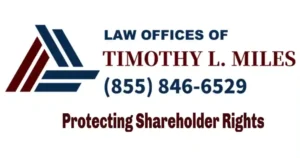Introduction to the Fortrea Class Action Lawsuit
The Fortrea class action lawsuit seeks to represent purchasers or acquirers of Fortrea Holdings Inc. (NASDAQ: FTRE) securities between July 3, 2023 and February 28, 2025, inclusive (the “Class Period”). Captioned Deslande v. Fortrea Holdings Inc., No. 25-cv-04630 (S.D.N.Y.), the Fortrea class action lawsuit charges Fortrea and certain of Fortrea’s top executives with violations of the Securities Exchange Act of 1934.
If you suffered substantial losses and wish to serve as lead plaintiff of the Fortrea class action lawsuit, or just have general questions about you rights as a shareholder, please contact attorney Timothy L. Miles of the Law Offices of Timothy L. Miles, at no cost, by calling 855/846-6529 or via e-mail at [email protected]. Lead plaintiff motions for the Fortrea class action lawsuit must be filed with the court no later than August 1, 2025.
The Pleading Requirements in a Securities Fraud Class Action Lawsuit
Pleading requirements in a securities fraud class action lawsuit are highly specific and dictated by several stringent standards set forth in federal securities laws. These requirements are designed to ensure that only meritorious claims proceed through the judicial system, thereby preventing frivolous litigation that could unduly burden corporations and waste judicial resources.
One of the primary statutes governing these lawsuits is the Private Securities Litigation Reform Act (PSLRA) of 1995. Under the PSLRA, plaintiffs must meet heightened pleading standards that go beyond the general requirements for civil complaints.
To initiate a securities fraud class action lawsuit, such as the Fortrea Class Action Lawsuit, plaintiffs must clearly articulate specific elements in their complaint. First and foremost, they must establish that there was a material misrepresentation or omission made by the defendant. This entails providing detailed factual allegations demonstrating how statements were false or misleading and how these misstatements or omissions were significant enough to influence an investor’s decision-making process.

Secondly, plaintiffs must show that the defendant acted with scienter, a legal term that refers to a wrongful state of mind. Scienter involves proving that the defendant had an intent to deceive, manipulate, or defraud investors.
This can be one of the most challenging aspects of a securities fraud case because it requires demonstrating that the defendant knowingly or recklessly disregarded the truth.
In the context of the Fortrea Class Action Lawsuit, for example, plaintiffs would need to present compelling evidence that corporate executives were deliberately deceptive in their communications with shareholders.
Another crucial element is the requirement of loss causation. Plaintiffs must show a direct link between the alleged fraud and the economic loss suffered by investors. This involves demonstrating that the misrepresentation or omission directly resulted in a decline in the value of the security. In other words, plaintiffs must illustrate how the truth, once revealed, caused their investment losses.
Furthermore, reliance is another key component in securities fraud class actions. Plaintiffs need to prove that they relied on the defendant’s misrepresentation or omission when making their investment decision. This reliance can often be established through a presumption known as “fraud-on-the-market” theory, which assumes that the price of a security traded in an efficient market reflects all public, material information—including any fraudulent statements.
Lastly, within these pleadings, plaintiffs must also ensure they meet procedural requirements such as filing within the statute of limitations. The PSLRA imposes specific timelines within which claims must be brought forward, typically two years from discovery of the facts constituting the violation and no more than five years after the violation occurred.
In summary, pleading requirements in a securities fraud class action lawsuit involve establishing material misrepresentation or omission, scienter, loss causation, and reliance while adhering to procedural timelines. For cases like the Fortrea Class Action Lawsu, meeting these criteria is imperative for advancing past preliminary motions and into substantive litigation stages. These rigorous standards serve to balance the protection of investors with safeguarding companies from unfounded allegations.
The Standard on a Motion to Dismiss a Securities Fraud Class Action
In a securities fraud class action lawsuit, the standard on a motion to dismiss is crucial in determining whether the case proceeds to discovery and potentially trial. To survive a motion to dismiss, the plaintiff must meet the pleading standards set forth by the Federal Rules of Civil Procedure, particularly Rule 9(b) and the PSLRA. Rule 9(b) requires that allegations of fraud be stated with particularity, meaning that the complaint must provide specific details about the fraudulent conduct, including the “who, what, when, where, and how” of the alleged fraud.
The PSLRA further heightens this requirement by mandating that plaintiffs specify each statement alleged to be misleading and the reasons why it is misleading. Additionally, plaintiffs must establish a “strong inference” of scienter, which involves showing that the defendants acted with intent to deceive, manipulate, or defraud investors.

In the context of the Fortrea Lawsuit, these standards are particularly relevant. The Fortrea Lawsuit involves allegations of securities fraud that must be scrutinized under these strict pleading requirements.
The court will examine whether the plaintiffs have provided detailed and specific allegations that clearly outline how Fortrea purportedly engaged in fraudulent activities. If the complaint merely offers vague or conclusory statements without substantive evidence of fraud or intent, it is likely to be dismissed at this early stage.
To withstand a motion to dismiss in such cases, plaintiffs often rely on internal documents, whistleblower accounts, or other evidence that can substantiate their claims. The court’s role at this stage is not to determine the truth of the allegations but to assess whether the complaint sufficiently alleges facts that, if proven, would constitute a violation of securities laws.
Should the Fortrea Lawsuit meet these stringent requirements, it would proceed to discovery, where more detailed evidence could be gathered to support the plaintiffs’ claims.
It is important for plaintiffs in securities fraud class action lawsuits to meticulously prepare their complaints, ensuring they meet all necessary legal standards. Failure to do so can result in dismissal at an early stage, precluding any opportunity for further investigation or recovery. Therefore, understanding and adhering to the pleading standards under Rule 9(b) and the PSLRA is essential for advancing such litigation successfully.
The Standard for Class Certification in a Securities Fraud Class Action
In the context of securities fraud class actions, such as the Fortrea Class Action Lawsuit the standard for class certification is a pivotal aspect that determines whether the case can proceed as a class action. Class certification is governed by Rule 23 of the Federal Rules of Civil Procedure, which sets forth several prerequisites that must be met to certify a class. These requirements include numerosity, commonality, typicality, and adequacy.
Numerosity implies that the class is so large that individual lawsuits would be impractical; commonality means there are questions of law or fact common to the class; typicality necessitates that the claims or defenses of the representative parties are typical of those of the class; and adequacy ensures that the representative parties will fairly and adequately protect the interests of the class.

In securities fraud cases like the Fortrea Class Action Lawsuit, an additional layer of complexity is added with the requirement for proving elements such as reliance, materiality, and causation.
Reliance often hinges on the presumption established by Basic Inc. v. Levinson, where plaintiffs may invoke a rebuttable presumption that they relied on public, material misrepresentations when they purchased or sold securities in an efficient market.
This presumption significantly influences the court’s decision on whether common questions predominate over individual ones—a crucial criterion for class certification under Rule 23(b)(3).
Moreover, materiality in a securities fraud class action must be demonstrated to show that the alleged misrepresentations or omissions were significant enough to affect an investor’s decision-making process.
For example, in the Fortrea Class Action Lawsuit, plaintiffs must establish that the misinformation provided by Fortrea was material and had a substantial impact on their investment decisions. Causation entails proving that the fraudulent actions directly caused financial losses to the investors, which is often done through expert testimony and financial analysis.
Finally, adequacy of representation in cases like the Fortrea Class Action Lawsuit is scrutinized to ensure that the lead plaintiffs have no conflicts of interest with other class members and are capable of managing the litigation effectively. This involves assessing both the qualifications and commitment of the attorneys representing the class as well as the integrity and dedication of the lead plaintiffs themselves.
Overall, achieving class certification in securities fraud litigations such as the Fortrea Class Action Lawsuit requires meticulous adherence to procedural rules and compelling arguments to satisfy all criteria under Rule 23. The successful certification not only consolidates numerous individual claims into a single cohesive lawsuit but also amplifies the chances for aggrieved investors to obtain redress for alleged fraudulent activities.
How a Settlement Is Distributed Equitably in a Securities Class Action Lawsuit
In a securities class action lawsuit, the settlement distribution process is designed to ensure that all eligible claimants receive an equitable share of the recovery. This involves a series of meticulously planned steps that are aimed at fairness and transparency. Firstly, once a settlement is reached, the court must approve the terms and conditions to ensure they are just and reasonable.
Subsequently, a notice is disseminated to all potential class members, informing them of their rights and the procedures for submitting claims. This notice typically includes information about the deadline for filing claims, the method for calculating individual payouts, and any documentation required to support a claim.

One crucial aspect of distributing settlement funds equitably is the development of a plan of allocation. This plan is crafted by legal experts who analyze various factors such as the extent of each claimant’s losses, the period during which they held the securities in question, and any other relevant criteria specified in the lawsuit.
For instance, in the Fortrea Lawsuit, a comprehensive plan would be established to determine how much each affected investor should receive based on their specific circumstances. The goal is to ensure that each participant receives a proportionate share of the settlement fund relative to their incurred losses.
The claims administration process plays a vital role in verifying and processing each claim submitted by class members. This phase involves scrutinizing the provided documentation, calculating allowable losses, and ensuring that each claim adheres to the criteria set forth in the settlement agreement.
To maintain transparency and fairness, an independent claims administrator is often appointed to oversee this process. This administrator handles queries from class members, resolves disputes, and ensures that the distribution is carried out impartially.
Once all claims are verified and approved, the final step involves disbursing the settlement funds. Payments are usually made via checks or electronic transfers directly to the claimants. In cases where there are unclaimed funds or residual amounts after the initial distribution, these may be allocated to remaining class members or used for other purposes as directed by the court.
The Fortrea Lawsuit serves as an illustrative example of how meticulous planning and execution are paramount in ensuring that settlements are distributed equitably in securities class action lawsuits. By adhering to established legal frameworks and maintaining a commitment to transparency throughout the process, all involved parties can achieve a fair resolution that compensates affected investors for their losses.
Frequently Asked Questions About Fortrea Lawsuit
What initiated the Fortrea lawsuit?
The lawsuit was initiated by investors alleging that Fortrea provided misleading information regarding its financial health and operations, resulting in financial losses.
How can I join the Fortrea lawsuit?
If you purchased shares during the class period and suffered a loss, then you are automatically a member of the class and do not need to do anything at this point unless you are considering moving for lead plaintiff.
What are the potential benefits of a Fortrea lawsuit?
Class action lawsuits allow individual investors to collectively seek justice and compensation, which might be challenging to pursue individually. They also promote corporate accountability.
How long will the Fortrea lawsuit take to resolve?
The duration of class action lawsuits can vary significantly, depending on the complexity of the case, legal strategies, and whether settlements are reached. It could take several months to years.
Contact Timothy L. Miles Today About a Fortrea Class Action Lawsuit
If you suffered losses in Fortrea stock, call us today for a free case evaluation about an Fortrea Class Action Lawsuit. 855-846-6529 or [email protected] (24/7/365).
Timothy L. Miles, Esq.
Law Offices of Timothy L. Miles
Tapestry at Brentwood Town Center
300 Centerview Dr. #247
Mailbox #1091
Brentwood,TN 37027
Phone: (855) Tim-MLaw (855-846-6529)
Email: [email protected]
Website: www.classactionlawyertn.com
Facebook Linkedin Pinterest youtube






